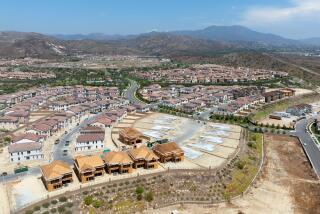Irvine Makes Cut in Traffic Load a Job for Developers
It was the kind of thing that could keep a traffic engineer awake at night: an enormous new office and industrial center with up to 75,000 new employees in the cradle formed by Orange Countyâs two major freeways.
Already, during morning commute hours, both freeways are crawling, noxious parking lots. Now, a proposed development by the Irvine Co. would add tens of thousands of cars to the Santa Ana and San Diego freeways and surrounding surface streets, enough to overburden even the $200 million worth of freeway interchanges and overpasses the company proposes to build.
The City of Irvine eventually authorized the development, named Irvine Spectrum, but it added an unusual condition: Full development could occur only if traffic was cut by 20% or more.
It meant that, somehow, businesses would have to keep more of their employees off the road, particularly during morning and afternoon rush hours.
Fewer Alternatives
The idea of accommodating more traffic on existing roads has been in vogue since the 1970s, when engineers began to realize there would never be enough money to build the freeways and transit systems needed for the nationâs cities.
However, the concept has begun to hit home in suburban California, where areas like Orange County and the bedroom communities around San Francisco Bay--still tract houses and orange groves when federal highway money was flowing freely to their urban neighbors--now have little choice in an era when the money has dried up and urbanization has moved in.
New companies moving into Irvine Spectrum--ranging from small computer component manufacturers to corporate offices for Kawasaki, Mazda and Parker-Hannifin--must agree to create traffic reduction plans and pay annual dues to a nonprofit association to help market them. The requirements are part of both the zoning and the deed restrictions.
Parker-Hannifin now operates a fleet of eight commuter vans, partially subsidized by the company, and allows employees who ride in them to pay through payroll deductions.
Burroughs Corp. offers shower rooms for workers who bicycle to work. Other companies have scheduled four-day workweeks or flexible work hours that allow employees to arrive before or after rush hour.
New Look at Traffic Control
Irvine city officials say no other development in the country has gone so far as to impose traffic limits in the zoning and deed restrictions on property before it is sold.
A growing number of communities--including some in Orange County--are looking at ordinances that would require businesses to adopt traffic control measures.
Pleasanton, a community near Oakland that suddenly has become the third fastest-growing area in the state, in 1984 became the first city in the nation to pass an ordinance requiring businesses to reduce their traffic.
While small companies merely are required to conduct surveys and provide car-pooling information to their employees, large employers must reduce peak-hour traffic by 45% before 1988. Those who donât at least make an attempt face fines or jail terms.
Model Ordinance to Be Drafted
The City of Concord, in Contra Costa County, soon followed suit, though its ordinance applies only to new development. Santa Clara, Walnut Creek, Contra Costa County and Alameda County are all now looking at similar ordinances.
And later this year, the Orange County Transportation Commission will draft a model ordinance for possible adoption by Orange Countyâs 26 cities.
âItâs become very, very apparent there is insufficient money to build all the highways and all the transit systems that urban areas are proposing, and even if you build them all, they can hardly keep up with the demand. So there is an attempt here to manage the system,â said G. J. Fielding, director of the Institute of Transportation Studies for the University of California.
âItâs happening all the time,â he said. âIf you look at the number of freeway ramps with metering, if you look at the increased attention weâre giving to arranging the signals on arterial streets, all of those little things, I think, weâre doing a better job. The problem is, our traffic is increasing faster than we can deal with it.â
Olympic Triumph
Southern Californiaâs experience with the Olympics in 1984 proved that traffic management could work.
Companies rescheduled their work hours, commuters shifted to surface streets and use of public transit and car pools increased a little. Freeway traffic increased 5% overall but flowed freely.
While most traffic engineers agree that the all-out efforts that went into the Olympics cannot be a way of life, even limited management can have a big impact on freeway traffic.
Peak hour congestion could be virtually eliminated on Orange Countyâs freeways, for example, simply by increasing the average number of occupants in each car from the current 1.2 to 1.4.
Steady Opposition
Yet, until now, mandatory programs have met with steady opposition.
The South Coast Air Quality Management District (AQMD) attracted broad support last year for a proposal to require large employers to offer ride-sharing incentives to workers. The AQMD staff said the plan could take as many as 200,000 cars a day off Los Angeles-area freeways and cut automobile pollutants by more than 100 tons a day.
But the AQMD board voted 8 to 5 to reject the proposal, one of the factors that earned Orange County board members Bruce Nestande and Harriett Wieder (both county supervisors) and Anaheim Mayor Don Roth âflunkingâ grades this week from the nonprofit Coalition for Clean Air.
Some opponents argued that it was not the AQMDâs role to regulate vehicle emissions, normally a job of the state Air Resources Board. Others, such as Nestande, said the problem of traffic congestion could not be addressed simply by car pooling, since whatever free space opened up would almost immediately be filled again by drivers who now avoid the freeways.
Cooperation in Pleasanton
Yet the Pleasanton ordinance, written with the help of land developers and business owners, had no opposition by the time it was adopted, when the cityâs population had grown by more than a third.
Since then, of the 34 major employers required to meet a first-year goal of reducing rush-hour traffic by 15%, all but two made it. Seven companies reduced traffic by the fourth-year goal of 45% in a single year.
In Irvine, city officials saw the inadequacy of usual efforts to reduce traffic when the Irvine Co. completed the new freeway interchange at Alton Parkway, the first it was required to build near Irvine Spectrum.
Less than a year after its opening, the $10.6-million interchange already is carrying 30,000 cars a day. And Spectrum is barely 15% under way.
Business Needs Persuasion
Irvine Co. spokeswoman Charity Crawford said businesses, which already contribute $200,000 a year to the traffic management association, have to be convinced of the potential company benefits. These might include greater worker productivity or access to labor markets in Riverside and San Diego counties because of quicker commuting times.
Parker-Hannifin, for example, has already noticed a drop in absenteeism that might be attributed to its van-pooling program, company spokesman Jay Johnson said.
At Kawasaki, employees who participate in the companyâs promotional motorcycle racing programs ride their bikes to work to keep in shape.
âThis whole transportation management planning thing has been kind of a voluntary thing up until now, mom-and-apple-pie-type statements: âWeâre all going to car pool and van pool,â â said Dennis Wilberg of the City of Irvineâs transportation department.
More Is Needed
âI think weâre just now getting to the point where thereâs actually this sort of action being taken, where thereâs specific requirements on development,â Wilberg said.
But even strict traffic management programs canât solve the problem entirely.
Fielding estimates that, if widely enforced, such restrictions can cut freeway traffic by as much as 20%. But in a growing area like central Orange County, he says, that wonât be enough.
Even with a 20% traffic reduction and plans to widen the Santa Ana and San Diego freeways--increasing their capacity by 10%--by the end of the century âyouâll still find 20% to 25% more demand upon the system than you can accommodate,â Fielding said.
âThe answer is, youâre going to have to build more facilities,â he said. âThereâs no way we can get around it.â
More to Read
Sign up for Essential California
The most important California stories and recommendations in your inbox every morning.
You may occasionally receive promotional content from the Los Angeles Times.










